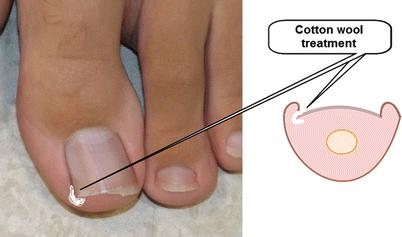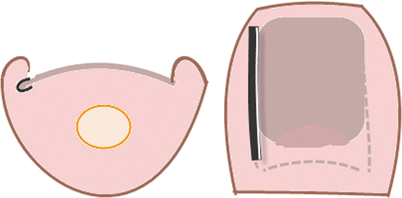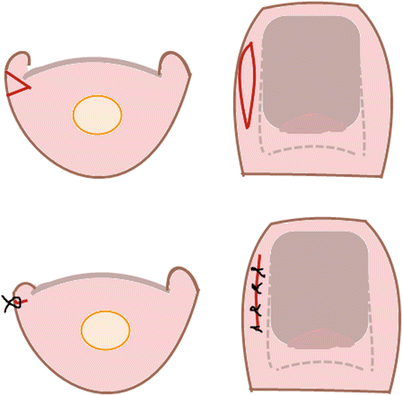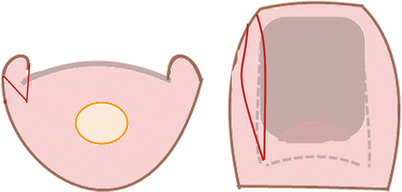Fig. 48.1
Clinical photograph-ingrown toenail
Ingrown toenail can be classified into 3 stages. Stage 1 is characterised by pain and inflammation. Stage 2 is essentially stage 1 with infection. Stage 3 is stage 2 with lateral nail fold hypertrophy [2].
Patients seek treatment when become symptomatic. Treatments options vary depending on the severity of the condition, previous treatment, frequency of recurrence and the healthcare provider expertise. Various surgical and non-surgical treatments have been advocated but there is a lack of evidence-based hierarchical indications for these treatments [4]. General hygienic measures are essential for successful treatment whether surgical or non surgical. They are also important in reducing the risk of infection and recurrence following surgery [5].
What Non-operative Methods Have Been Described in the Literature?
The main principle of non-operative treatments is to prevent any physical contact between the nail edge and its nail fold. This will reduce the pressure in the surrounding soft tissue to allow for the inflammation and pain to settle down.
Cotton wool pledgets or wisps can be placed underneath the ingrown nail edge (Fig. 48.2). Senapati described their technique, which involved cutting the nail straight across, placing a small piece of cotton wool under the free corner of the nail and cauterising the granulation tissue with a silver nitrate stick. They quoted a success rate of 79 % at mean of 23.7 weeks follow up [6]. Connolly and Fitzgerald used cotton wool pledgets in children with 72 % success rate at mean of 2.5 years follow up [7].


Fig. 48.2
A drawing illustrating the cotton wall treatment
Toe taping is another alternative, where an elastic adhesive tape is used to pull the affected nail fold away from the lateral nail edge. It may take away the pain instantly. However, the symptoms can easily recur if the taping treatment is discontinued early. The usual length of time for this treatment is around 2 months. The success rate of this technique was reported to be less than 50 % [8, 9]. Tsunoda et al. showed that 265 out of their 541 patients who were treated with taping required additional treatment [9].
Splints such as gutter or resin splints have been described in the literature. They are affixed to the nail edge and this allows the nail edge to grow over the nail fold. Hence, the treatment sometimes takes several months to complete [10]. Matsumoto study quoted resin splint recurrence rate as 8.2 % with average duration of splint placement of 9.3 months [11] (Fig. 48.3).


Fig. 48.3
Schematic illustration of gutter splint treatment
Shape-memory alloy was recently developed in Korea and reviewed by Park et al. [12] in their short-term study. They claimed that its application is simple. The alloy has a hook at each end, which hold onto the nail edge keeping it away from the nail fold. In 24 patients (31 nails) who were treated with these alloys the recurrence rate for stage 1, 2 and 3 was 22.2 %, 33.3 % and 14.2 % respectively. One patient lost his nail. They claimed that they are simple to apply; they cause no deformity and patients have high satisfaction.
What Operative Methods Have Been Described in the Literature?
Several surgical techniques have been described in the literature to treat ingrown toenails. This indicates that none of these techniques is clearly more successful than others. Newer techniques keep coming and rarely bring substantive progress [5]. Surgical approaches are usually fall in one of three categories:
- 1.
Nail folds optimisation (Debulking of the hypertrophic nail fold and granulation tissue)
- 2.
Nail plate optimisation ( including nail matrix ablation)
- 3.
A combination of the above two approaches
The nail fold can be excised without disturbing the nail and its matrix. Several techniques have been described with slight modification regarding the size, the direction of the incision and the amount of soft tissue excised [13–17]. The reported short term results are good however the long term results are often missing. A study in 50 children reported no recurrence with very high patient satisfaction [18]. Potential complications in this technique are bleeding, nail deformity, and excessive granulation tissue. In another study, authors reported excellent short term results in 23 patients who were treated with foldplasty with no recurrences or severe complications over 12 months follow up period (Fig. 48.4).


Fig. 48.4
Schematic illustration of a fusiform excision to reduce the hypertrophic nail fold
Simple nail removal, either part or all of the nail plate has a recurrence rate up to 70 % [5, 19, 20]. That is why the nail matrix is normally either excised or chemically destroyed with either phenol or sodium hydroxide (corrosive base) as well. This is also known as matricectomy.
Total nail bed and matrix excision (Zadik’s operation) [21] has been promoted as the last resort treatment for patients with significant morbidity associated with ingrown toe nail. However, the reported recurrence rates with total nail ablation are high (18–60 %) undermining the reasoning for the indication [22, 23].
Partial excision of the nail and its matrix seems a less invasive intervention. This was first described by Winograd [24] and subsequently underwent several modifications. The most common modification in use is the wedge resection (Fig. 48.5). The nail plate edge is trimmed by about 2 mm and the matrix is destroyed surgically using a curette or blade. The reported recurrence rate varied from 16 % to 30 % [25, 26].


Fig. 48.5
Schematic illustration of wedge excision
Physical and chemical cauterisations have been used to further ensure complete destruction of the matrix and reduce the risk of recurrence. The addition of [27] Phenol has been shown to have better short and long term results compared to matrix surgical excision alone [4, 25, 28–33]. Phenol is widely used in practice compared to sodium hydroxide and both have good comparable results compared to matrix excision only [23, 34]. Bostanci et al. reviewed these two chemical agents in their patients and found that sodium hydroxide causes less postoperative morbidity and provides faster recovery [20]. Cryotherapy and electrocautery are another treatment options for matricectomy with low recurrence rates reported by Küçüktaş [35]. Matrix phenolisation however had reduced healing time compared to matrix electrocautery in a study by Misiak [36].
What Is the Best Treatment for Ingrown Toenail?
In the previous sections we presented the most commonly used treatments (surgical and non surgical) for ingrown toenails with brief description, pros and cons. In a comprehensive systematic review and meta-analysis published by Cochrane library, Eekhof et al. compared the outcomes of these treatments [4]. Twenty-four randomised controlled trials were included with a total of 2826 participants. Five studies investigated various non surgical treatments and 19 studied surgical treatments. Recurrence rate was the commonest outcome used. They found surgical treatments in general were superior to non surgical ones in term of recurrence rates (13 % versus 32 % respectively). The use of chemical ablation seems to reduce the recurrences rates regardless the surgical interventions although the comparatives varied. The crude recurrence rates were 20 % in wedge resection alone. The addition of chemical will reduce the recurrence rate to around 11 %. Moreover, wedge excision achieved similar recurrent rate as total avulsion of the nail [28] but performed better than foldoplasty [37] (Table 48.1).
Table 48.1




Table of recommendations
Stay updated, free articles. Join our Telegram channel

Full access? Get Clinical Tree







